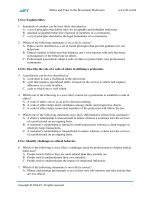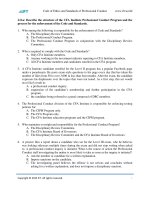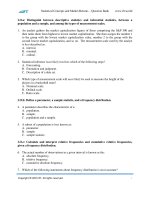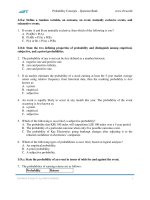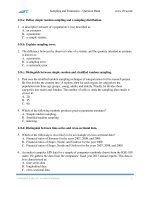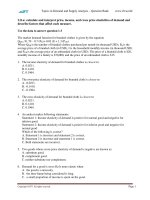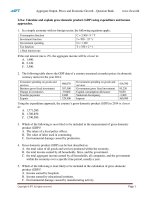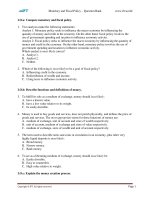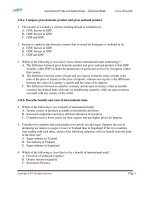CFA 2018 quest bank r08 statistical concepts and market returns q bank
Bạn đang xem bản rút gọn của tài liệu. Xem và tải ngay bản đầy đủ của tài liệu tại đây (499.58 KB, 24 trang )
Statistical Concepts and Market Returns – Question Bank
www.ift.world
LO.a: Distinguish between descriptive statistics and inferential statistics, between a
population and a sample, and among the types of measurement scales.
1. An analyst gathers the market capitalization figures of firms comprising the S&P 500 and
then ranks them from highest to lowest market capitalization. She then assigns the number 1
to the group with the lowest market capitalization value, number 2 to the group with the
second lowest market capitalization, and so on. The measurement scale used by the analyst
is best described as:
A. interval.
B. nominal.
C. ordinal.
2. Statistical inference least likely involves which of the following steps?
A. Forecasting.
B. Estimation and judgment.
C. Description of a data set.
3. Which type of measurement scale will most likely be used to measure the height of the
players in a basketball team?
A. Nominal scale.
B. Ordinal scale.
C. Ratio scale.
LO.b: Define a parameter, a sample statistic, and a frequency distribution.
4. A parameter describes the characteristic of a:
A. population.
B. sample.
C. population and a sample.
5. A subset of a population is best known as:
A. parameter.
B. sample.
C. sample statistic.
LO.c: Calculate and interpret relative frequencies and cumulative relative frequencies,
given a frequency distribution.
6. The actual number of observations in a given interval is known as the:
A. absolute frequency.
B. relative frequency.
C. cumulative absolute frequency.
7. Which of the following statements about frequency distribution is most accurate?
Copyright © 2015 IFT. All rights reserved.
1
Statistical Concepts and Market Returns – Question Bank
www.ift.world
A. An observation can fall in more than one interval.
B. The data is sorted in a descending order for the construction of a frequency distribution.
C. The cumulative relative frequency tells the observer the fraction of the observations that
are less than the upper limit of each interval.
LO.d: Describe the properties of a data set presented as a histogram or a frequency
polygon.
8. Which of the following statements about histograms is least likely accurate?
A. A histogram is the graphical equivalent of a frequency distribution.
B. A histogram is a form of a bar chart.
C. In the histogram, the height represents the relative frequency for each interval.
9. Which of the following graphical tools for displaying data require the mid points to be
plotted for each interval?
A. Frequency polygon.
B. Histogram.
C. Cumulative frequency curve.
10. The following table shows the average monthly returns of a portfolio over the past one year:
Month
January
February
March
April
May
June
Return (%)
10%
15%
14%
11%
8%
3%
Month
July
August
September
October
November
December
Return (%)
5%
6%
7.5%
9%
12%
11%
The following intervals are used for the construction of the frequency polygon:
Interval
1
13 < r < 15
The cumulative relative frequency for the interval „10 < r <12‟ is equal to:
A. 16.67%.
B. 33.33%.
C. 83.33%.
Copyright © 2015 IFT. All rights reserved.
2
Statistical Concepts and Market Returns – Question Bank
www.ift.world
LO.e: Calculate and interpret measures of central tendency, including the population
mean, sample mean, arithmetic mean, weighted average or mean, geometric mean,
harmonic mean, median, and mode.
11. An analyst computes the geometric mean of a portfolio that has yearly returns of: -8%, 2%, 4%, 7%, and 12%. The geometric mean computed by the analyst is closest to:
A. 1.50%.
B. 1.80%.
C. 2.10%.
12. Considering the following set of numbers.
40
48
37
47
44
41
51
41
40
69
53
42
39
55
41
47
45
57
Which of the following statements is least likely accurate?
A. The mode is larger than the mean.
B. The median is smaller than the mean but larger than the mode.
C. The mean is larger than both the mode and the median.
13. The following ten observations are a sample drawn from a normal population: 24, 5, 12, 6, 3, 11, 18, 15, -4, and 29. The mean of the sample is closest to:
A. 11.30.
B. 12.90.
C. 14.00.
14. Over the past five years, a portfolio gave returns of 18%, 12% -5%, -10% and 7%. The
geometric mean return of the portfolio over the five year period is closest to:
A. 3.87%.
B. 4.40%.
C. 10.31%.
15. A portfolio has the following annual returns: 5%, 11%, -6%, 0%. The geometric mean across
the four-year period is closest to:
A. 2.3%.
B. 2.5%.
C. 2.6%.
16. The table below shows some sample figures:
-25
2
13
-12
6
19
-2
7
20
0
9
21
Copyright © 2015 IFT. All rights reserved.
1
11
25
3
Statistical Concepts and Market Returns – Question Bank
29
39
41
55
www.ift.world
65
The median value of the above items is closest to:
A. 11.
B. 12.
C. 13.
17. The discount rate set by the central bank of country XYZ for the past 6 quarters is shown
below:
Quarter
1
2
3
Discount Rate
10.0%
10.5%
11.4%
Quarter
4
5
6
Discount Rate
8.5%
9.6%
11.5%
The sample mean rate for the 6 quarters is closest to:
A. 10.25%.
B. 11.24%.
C. 12.3%.
18. Which of the following statements about arithmetic mean is most accurate?
A. Deviations from the arithmetic mean indicate risk.
B. The product of the deviations around the mean is equal to 0.
C. The disadvantage of an arithmetic mean is it fails to make use of all data.
19. The discount rate set by the central bank of Romulus for the past 6 quarters is shown below:
Quarter
1
2
3
Discount Rate
10.0%
10.5%
11.4%
Quarter
4
5
6
Discount Rate
8.5%
9.6%
11.5%
The median is closest to:
A. 10.25%.
B. 10.50%.
C. 11.25%.
20. The following table shows the intervals for temperatures recorded at different places all over
the country. The respective frequency for each interval represents the number of towns and
cities.
Interval
0 < r < 10
10 < r < 20
Frequency
29
37
Copyright © 2015 IFT. All rights reserved.
4
Statistical Concepts and Market Returns – Question Bank
20 < r < 30
30 < r < 40
40 < r < 50
www.ift.world
31
35
33
The modal interval of this distribution is most likely:
A. 0 < r < 10.
B. 10 < r < 20.
C. 30 < r < 40.
21. A portfolio manager is computing the weighted mean of a portfolio, whose asset allocation as
of 31 December, 2012, is given below:
Local Equities:
25%
International Equities:
13%
Bonds:
27%
Mortgage:
18%
Gold:
17%
The returns on the above assets on 31 December, 2012, were 5.4%, 8.9%, -2.5%, -7%, and
11% respectively. The mean return earned by the portfolio is closest to:
A. 2.44%.
B. 3.16%.
C. 4.88%.
22. Judith Owen buys a share for $45 on January 1, 2011. The price of the share is $54 on
January 1, 2012 and $63 on January 1, 2013. Assuming no dividends were paid, which of the
following best represent the geometric mean annual return earned by Owen over the two year
period?
A. 18.32%.
B. 18.34%.
C. 30.21%.
23. Sam Pepper is an investor, who buys $2,000 of a stock every quarter. The price of the stock
over the last three quarters was $20, $22, and $25 per share. The harmonic mean of the
stock‟s price is closest to:
A. $22.33.
B. $22.15.
C. $22.06.
24. If all the observations in a data set have different values, then which of the following
relationships is most accurate?
A. Arithmetic Mean < Geometric Mean < Harmonic Mean.
B. Geometric Mean < Harmonic Mean < Arithmetic Mean.
C. Harmonic Mean < Geometric Mean < Arithmetic Mean.
Copyright © 2015 IFT. All rights reserved.
5
Statistical Concepts and Market Returns – Question Bank
www.ift.world
LO.f: Calculate and interpret quartiles, quintiles, deciles, and percentiles.
25. The following table shows the returns of various stocks of a portfolio, ranked in ascending
order:
Stock
Stock 1
Stock 2
Stock 3
Stock 4
Stock 5
Return (%)
10.50
11.25
12.05
12.65
13.55
Stock
Stock 6
Stock 7
Stock 8
Stock 9
Stock 10
Return (%)
14.24
14.75
15.30
16.00
17.45
The value of the third quintile is closest to:
A. 15.475%.
B. 14.55%.
C. 15.30%.
26. The table below shows data on volatility of a series of funds:
Fund 1
Fund 2
Fund 3
Fund 4
Fund 5
Fund 6
Fund 7
Fund 8
Fund 9
Fund 10
Fund 11
Fund 12
Fund 13
Volatility (%)
5.05%
6.20%
6.93%
7.56%
8.25%
10.11%
11.36%
14.52%
15.02%
15.66%
15.98%
16.01%
19.25%
The value of the second quintile is closest to:
A. 7.56%.
B. 9.37%.
C. 10.11%.
27. Which of the following statements is least accurate?
A. The first quintile generally exceeds the first decile.
B. The first quintile generally exceeds the first quartile.
C. The third quintile generally exceeds the median.
Copyright © 2015 IFT. All rights reserved.
6
Statistical Concepts and Market Returns – Question Bank
www.ift.world
28. The following ten observations are a sample drawn from a normal population: 6, 12, 32, -12,
10, 3, -21, 15, 8, and 11. The third quintile (60th percentile) of the sample is closest to:
A. 3.0.
B. 10.6.
C. 11.0.
29. Which of the following statements is least likely accurate?
A. The median is the 50th percentile.
B. Quintiles divide the distribution into fifths.
C. Linear interpolation is used when the location, L, is a whole number.
30. The following table shows the earnings per share (EPS) of 20 hypothetical companies.
Company
AB
CDE
FG
HIJ
KLM
NO
PQR
STU
VWX
EPS
$4.50
$14.50
$9.33
$7.21
$6.44
$6.99
$6.27
$8.11
$5.25
Company
AAA
BBB
CCC
DDD
EEE
FFF
GGG
HHH
III
EPS
$13.22
$13.25
$12.98
$11.54
$11.73
$15.00
$10.49
$5.78
$6.50
YZ
$12.15
JJJ
$4.75
The 30th percentile is closest to:
A. 6.44.
B. 6.29.
C. 6.99.
31. For a data set of 100 observations, which of the following best represents a quintile?
A.
.
B.
.
C.
.
32. The second quartile represents which of the following?
I.
Median
II.
50th percentile
III.
2nd quintile
IV.
5th decile
A. I and II only.
B. I, II, and IV only.
C. II, III, and IV only.
Copyright © 2015 IFT. All rights reserved.
7
Statistical Concepts and Market Returns – Question Bank
www.ift.world
LO.g: Calculate and interpret 1) a range and a mean absolute deviation and 2) the variance
and standard deviation of a population and of a sample.
33. Which of the following is closest to the sample variance of the observations given below?
-5
4
7
11
4
-8
-1
3
5
A. 31.3.
B. 33.7.
C. 35.2.
34. The following observations are drawn from an approximately normal population:
Observation 1 2 3 4 5
Value
13 -5 1 3 -8
The sample standard deviation is closest to:
A. 7.22.
B. 7.86.
C. 8.13.
35. UBL Fund‟s return for the last five years are as follow:
Year
2009
2010
2011
2012
2013
Return (%)
-12
10
15
17
19
The mean absolute deviation of returns for this fund is closest to:
A. 8.72%.
B. 9.00%.
C. 9.50%.
36. The annual returns of a stock portfolio since its inception on 1 January 2008 is given below:
Year
2008
2009
Portfolio return
7.5%
9.0%
Copyright © 2015 IFT. All rights reserved.
8
Statistical Concepts and Market Returns – Question Bank
www.ift.world
2010
11.5%
2011
-5.3%
2012
9.7%
The portfolio‟s mean absolute deviation for the five-year period is closest to:
A. 3.42%.
B. 4.71%.
C. 6.50%.
37. The returns of a fund are given below:
Year
Return %
2009
5.0
2010
-3.2
2011
6.1
2012
4.5
2013
1.3
The mean absolute deviation of returns for this fund is closest to:
A. 3.55.
B. 2.95.
C. 3.95.
38. The table below shows the temperatures recorded at different places:
Place
A
B
C
D
Temperature (degree Celsius)
48
21
10
-8
Place
E
F
G
H
Temperature (degree Celsius)
51
35
16
-15
The range for this data is closest to:
A. 26.
B. 36.
C. 66.
39. The weekly rainfall received by some areas in Australia during June 2013 is tabulated below:
Port Hedland
Gove
Millbrook
Tree House Creek
Thredbo
100 mm
15 mm
107 mm
120 mm
178 mm
Falls Creek
Esperance
Mt Read
Samuel Hill
Hunters Hill
176 mm
66 mm
74 mm
113 mm
132 mm
The range for this data set is closest to:
A. 108 mm.
B. 163 mm.
Copyright © 2015 IFT. All rights reserved.
9
Statistical Concepts and Market Returns – Question Bank
www.ift.world
C. 178 mm.
40. The number of pages read by a group of students per day is given below:
Patrick
Salis
Melisa
Tina
Thomas
100
65
27
120
34
Fiona
James
Nelson
Samuel
Gordon
175
50
20
75
90
The mean absolute deviation (MAD) is closest to:
A. 36.5.
B. 55.6.
C. 75.6.
41. The dividend yield for five hypothetical companies is given below:
Paknama
Genie Ltd.
Mirinda Corp.
Tina Travels Ltd.
Thomas Press Ltd.
10.5%
16.25%
27.0%
12.0%
7.8%
The population variance is closest to:
A. 36.89.
B. 45.20.
C. 56.49.
42. The return on equity for four hypothetical companies is given below:
Little Wonder
Genesis Ltd.
Moral Corp.
Travis Ltd.
10.5%
16.25%
9.81%
12.0%
The population standard deviation is closest to:
A. 2.50.
B. 2.88.
C. 6.25.
43. The dividend yield for five hypothetical companies from a list of 100 companies is given
below:
Paknama
Genie Ltd.
Mirinda Corp.
10.5%
16.25%
27.0%
Copyright © 2015 IFT. All rights reserved.
10
Statistical Concepts and Market Returns – Question Bank
Tina Travels Ltd.
Thomas Press Ltd.
www.ift.world
12.0%
7.8%
The sample variance is closest to:
A. 36.89.
B. 45.20.
C. 56.49.
44. The return on equity for four hypothetical companies from a list of 100 companies is given
below:
Little Wonder
Genesis Ltd.
Moral Corp.
Travis Ltd.
10.5%
16.25%
9.81%
12.0%
The sample standard deviation is closest to:
A. 2.50.
B. 2.88.
C. 6.25.
45. Semivariance is defined as the average squared deviation:
A. below the mean.
B. equivalent to the mean.
C. above the mean.
LO.h: Calculate and interpret the proportion of observations falling within a specified
number of standard deviations of the mean using Chebyshev’s inequality.
46. According to Chebyshev‟s inequality, in a population of 1000 what is the minimum
proportion of observation that must lie within three standard deviations of the mean,
regardless of the shape of the distribution?
A. 75%.
B. 89%.
C. 99%.
47. A sample of 320 observations is randomly selected from a population. The mean of the
sample is 144 and the standard deviation is 12. Based on Chebyshev‟s inequality, the
endpoints of the interval that must contain at least 75% of the observations are closest to:
A. 108 and 180.
B. 120 and 168.
C. 135 and 153.
48. According to Chebyshev‟s inequality, at least 88.89 percent of the observations for any
distribution must lie within:
A. 1 standard deviation of the mean.
Copyright © 2015 IFT. All rights reserved.
11
Statistical Concepts and Market Returns – Question Bank
www.ift.world
B. 2 standard deviations of the mean.
C. 3 standard deviations of the mean.
LO.i: Calculate and interpret the coefficient of variation and the Sharpe ratio.
49. A portfolio of large-cap companies‟ stocks generated a mean portfolio return of 20% when
the risk free rate was 6% in the economy. The variance of portfolio returns was found to be
0.025. The Sharpe ratio of the portfolio is closest to:
A. 0.26.
B. 0.89.
C. 0.92.
50. Diana Sorenson, an equity fund manager has the following information about a common
stock portfolio:
Arithmetic mean return
12.9%
Geometric mean return
10.3%
Portfolio beta
1.6
Risk-free rate of return
3.50%
Variance of returns
212
From the given information, the coefficient of variation is closest to:
A. 1.13.
B. 1.41.
C. 1.55.
51. An analyst gathered following information on a common stock portfolio:
Arithmetic mean return
15.0%
Geometric mean return
13.2%
Portfolio beta
1.22
Risk-free rate of return
5.0%
Variance of returns
520
From the given information, the Sharpe Ratio is closest to:
A. 0.36.
B. 0.44.
C. 0.66.
52. The table below shows information about three portfolios:
Portfolio
Mean return on
portfolio (%)
Copyright © 2015 IFT. All rights reserved.
Standard deviation
of the
return on the
portfolio (%)
12
Statistical Concepts and Market Returns – Question Bank
www.ift.world
A
16
32
B
11
15
C
9
8
If the risk-free rate is 3%, which portfolio has the highest Sharpe ratio?
A. A.
B. B.
C. C.
53. The table below provides data on annual mean returns and standard deviations for three
bonds:
Asset Class
Bond A
Bond B
Bond C
Arithmetic mean return (%)
16.4%
12.6%
14.8%
Standard deviation of return (%)
4.9%
3.5%
4.2%
Which of the above bonds is least risky using a relative measure?
A. Commercial Bond A.
B. Corporate Bond B.
C. Government Bond C.
54. The table below summarizes the performance data for three portfolios:
Portfolio
Portfolio A
Portfolio B
Portfolio C
Arithmetic mean return (%)
16.4%
12.6%
14.8%
Variance of (%)
4.9%
3.5%
4.2%
Given that the mean return on the risk-free asset is 10.5 percent, which portfolio is most
likely to have the highest Sharpe ratio?
A. Portfolio A.
B. Portfolio B.
C. Portfolio C.
LO.j: Explain skewness and the meaning of a positively or negatively skewed return
distribution.
55. A distribution more peaked than the normal distribution is best described as being:
A. platykurtic.
B. mesokurtic.
C. leptokurtic.
56. In a continuous distribution where the graph shows the right tail of the curve to be longer
than the left tail is best described as having:
Copyright © 2015 IFT. All rights reserved.
13
Statistical Concepts and Market Returns – Question Bank
www.ift.world
A. lepto-kurtosis.
B. negative skewness.
C. positive skewness.
57. Which of the following return distribution is most likely characterized by frequent small
losses and a few large gains?
A. Normal distribution.
B. Negatively skewed.
C. Positively skewed.
58. Which of the following relationships best characterize a negatively skewed distribution?
A. Mean < median < mode.
B. Mode < median < mean.
C. Median < mean < mode.
59. Which of the following statements best describe a positively skewed distribution?
A. A distribution skewed to the right.
B. A distribution skewed to the left.
C. A distribution skewed upward.
LO.k: Describe the relative locations of the mean, median, and mode for a unimodal,
nonsymmetrical distribution.
60. If a distribution exhibits negative skewness, then the mean most likely is located to the:
A. left of both the median and mode.
B. right of both the median and mode.
C. left of the mode and right of the median.
61. Which of the following is most likely to be the largest in a positively skewed unimodal
distribution?
A. Mean.
B. Median.
C. Mode.
LO.l: Explain measures of sample skewness and kurtosis.
62. Equity return series are best described as:
A. mesokurtotic.
B. platykurtotic.
C. leptokurtotic.
63. A distribution that is less peaked than normal is most accurately described as:
A. leptokurtotic.
Copyright © 2015 IFT. All rights reserved.
14
Statistical Concepts and Market Returns – Question Bank
www.ift.world
B. mesokurtotic.
C. platykurtotic.
64. Which of the following statistical measures most likely measure the peakedness of a
distribution such as more or less peaked than a normal distribution?
A. Skewness.
B. Chebyshev‟s inequality.
C. Kurtosis.
65. A distribution identical to a normal distribution is:
A. Leptokurtic.
B. Mesokurtic.
C. Platykurtic.
LO.m: Compare the use of arithmetic and geometric means when analyzing investment
returns.
66. An analyst calculates the geometric and arithmetic means for the same set of data which has
variability in the observations. In this case, the geometric mean will most likely be:
A. equal to the arithmetic mean.
B. greater than the arithmetic mean.
C. less than the arithmetic mean.
Copyright © 2015 IFT. All rights reserved.
15
Statistical Concepts and Market Returns – Question Bank
www.ift.world
Solutions
1. C is correct. The analyst is using an ordinal scale which involves sorting data into categories
based on some characteristic, such as the firms‟ market capitalization value.
2. C is correct. The steps involved in statistical inference include forecasting, making estimates,
or using a smaller group to make judgments about a larger group. Description of important
aspects comes under descriptive statistics.
3. C is correct. The height of basketball players in a team is measured on a ratio scale as it is
possible to express in terms of a ratio. For example, the height of player A is 1.2 times the
height of player B, etc.
4. A is correct. A parameter describes the characteristic of a population while a sample statistic
describes the characteristic of a sample.
5. B is correct. A subset of a population is known as a sample.
6. A is correct. The actual number of observations in a given interval is known as the absolute
frequency. Relative frequency is the absolute frequency of each interval divided by the total
number of observations. Cumulative absolute frequency is the sum of all absolute
frequencies.
7. C is correct. The cumulative relative frequency is the fraction of the observations that are less
than the upper limit of each interval. A is incorrect as an observation cannot fall in more than
one interval. B is incorrect as the data is sorted in ascending order for the construction of a
frequency distribution.
8. C is correct. In the histogram, the height represents the absolute frequency for each interval.
9. A is correct. For a frequency polygon, the mid points for each interval are plotted on the x-axis
and the absolute frequency for that interval on the y-axis.
10. C is correct.
Interval
1
13 < r < 15
Frequency
1
2
3
4
2
Relative Frequency
8.33%
16.67%
25%
33.33%
16.67%
Cumulative Relative Frequency
8.33%
25%
50%
83.33%
100%
.
Copyright © 2015 IFT. All rights reserved.
16
Statistical Concepts and Market Returns – Question Bank
www.ift.world
Cumulative relative frequency is the sum of subsequent relative frequencies. Thus the
cumulative relative frequency is 83.33% for the interval 10 < r <12.
11. A is correct.
[(
)
(
)
(
)
(
)
(
)]
12. B is correct. The mode is the most frequent value in the set of items and thus is equal to 41.
The mean is the average value from the set of items and is computed as follows:
The median is the value of the middle item of a set of items and is computed as the average
of the n/2th item and the (n+2)/2th item which is the 9th and 10th item. The median is thus
44.5.
Therefore the median is smaller than the mean but larger than the mode.
13. A is correct. The sum of the ten numbers is 113. Dividing by 10 gives the mean of 11.30.
14. A is correct. Add one to each of the given returns, then multiply them together, then take the
fifth root of the resulting product. 1.18 × 1.12 × 0.95 × 0.90 × 1.07 = 1.209066. 1.209066
raised to the 0.20 power is 1.0387. Subtracting one and multiplying by 100 gives the correct
geometric mean return of 3.87%.
15. A is correct. The geometric mean return is calculated as [(1 + 0.05) × (1 + 0.11) × (1 - 0.06)
× (1 + 0.00)] 0.25 – 1 = 0.0231 ~ 2.3%.
16. B is correct. Median is the value of the middle item of a set of items. The value of the 10th
item is 11; the value of the 11th item is 13. The mean of 11 and 13 is 12.
17. A is correct.
∑
18. A is correct. B is incorrect because the sum of the deviations around the mean is equal to 0. C
is incorrect because the advantage of an arithmetic mean is that it makes use of all data.
19. A is correct. Arrange the data in ascending order as: 8.5, 9.6, 10.0, 10.5, 11.4, 11.5
Since there are an even number of observations, take the average of the two middle values to
calculate median:
Median = 10.25 percent
Copyright © 2015 IFT. All rights reserved.
17
Statistical Concepts and Market Returns – Question Bank
www.ift.world
20. B is correct. The modal interval is the interval with the highest frequency, which in this case,
is 10 < r < 20.
21. A is correct. Mean portfolio return is the weighted average of each asset class‟ returns.
̅̅̅̅
(
)
(
)
(
)
(
)
(
)
22. A is correct. First, calculate the holding period returns at the end of year 1 and year 2.
[(
)(
)]
23. B is correct.
*( )
( )
( )+
24. C is correct. Unless all observations in a data set are equal, the harmonic mean is less than
the geometric mean which is less than the arithmetic mean.
25. B is correct. The position of the third quintile can be found through the following formula:
(
) ( ); Where, y is the percentage point at which we are dividing the
distribution. Here, y = 60, the 60th percentile (third quintile);
n = 10
(
) ( ) = 6.6
Therefore, the location of the third quintile is between the return of Stock 6 and Stock 7.
Linear interpolation is used for finding the approximate value of the third quintile.
In the above case, return on the 6th stock is 14.24% and on the 7th stock is 14.75%. L60 =
14.55% which is 14.24% (6th value) plus 0.6 times the linear distance between 14.24% and
14.75%.
26. B is correct. Quintiles divide data into five parts. Hence the first quintile corresponds to the
20th percentile and the second quintile corresponds to the 40th percentile. The location can be
(
) ( )
(
) ( ) = 5.6. The value
determined using:
corresponding to location 5 (Fund 5) is 8.25%. The value corresponding to location 6 (Fund
6) is 10.11%. The approximate value corresponding to location 5.6 can be estimated using
linear interpolation:
(
(
–
)) = 9.37%.
27. B is correct. The first quintile is the 20th percentile and the third quintile is the 60th
percentile. The first decile is the 10th percentile, the first quartile is the 25th percentile, and
the median is the 50th percentile. While it is possible that these various percentiles or some
Copyright © 2015 IFT. All rights reserved.
18
Statistical Concepts and Market Returns – Question Bank
www.ift.world
subsets of them might be equal (for example the10th percentile possibly could be equal to the
20th percentile), in general the order from smallest to largest would be: first decile, first
quintile, first quartile, median.
28. B is correct. First we need to sort the data in ascending order: -21, -12, 3, 6, 8, 10, 11, 12, 15,
32. The third quintile corresponds to the 60th percentile. The location of the 60th percentile is
given by: L60 = (10 + 1) 60 / 100 = 6.6. The value is estimated using linear interpolation: P60
= 10 + 0.6(11 – 10) = 10.6.
29. C is correct. Linear interpolation is used when the location, L, is not a whole number and lies
between two closest integers.
30. A is correct.
The 30th percentile is the value at or below which 30 percent of observations lie.
To solve this problem, we first arrange the 20 data points in ascending order: 4.50, 4.75,
5.25, 5.78, 6.29, 6.44, 6.50, 6.99, 7.21, 8.11, 9.33, 10.49, 11.54, 11.73, 12.15, 12.98, 13.22,
13.25, 14.50, and 15.00.
The location of the 30th percentile is 30% of 20 = 6. The 6th data point is 6.44.
(
)( ) (
)( )
We can also use the location formula:
(
)(
)
(
)(
)
The two numbers (6.44 and 6.46) are different because the percentile calculations using the
location formula gives an approximate answer when n is small.
31. B is correct. Since quintiles divide the distribution into fifths, they are represented as
.
32. B is correct. The second quartile is equivalent to the median, the 50th percentile, and the
5th decile.
33. C is correct.
Using your calculator:
[2ND][DATA]
[2ND][CLR WORK]
5[+/-] [ENTER]
[↓][↓]4 [ENTER]
[↓][↓]7[ENTER]
[↓][↓]11[ENTER]
<and so on for the rest of the data>
[2ND][STAT]
Press [2ND][SET] repeatedly until you get I-V
Press[↓] to begin computing results.
You‟ll Sx (sample standard deviation) = 5.93; simply square this to get the
variance = 35.19
Copyright © 2015 IFT. All rights reserved.
19
Statistical Concepts and Market Returns – Question Bank
www.ift.world
34. C is correct.
Observation Value Difference from Mean Difference2
1
2
3
4
5
Sum
Mean
13
-5
1
3
-8
4
0.8
12.2
-5.8
0.2
2.2
-8.8
148.84
33.64
0.04
4.84
77.44
264.8
The sample variance is given by
̅) ⁄
∑ (
s2 = 264.8/5-1 = 66.2
The sample standard deviation is simple the square root of the sample variance. The
sample standard deviation is 8.13.
OR
Keystrokes
Explanation
[2nd] [DATA]
Enter data entry mode
[2nd] [CLR WRK]
Clear data registers
Display
X01
13 [ENTER]
X01 = 13
[↓] [↓] 5 +/- [ENTER]
X02 = -5
[↓] [↓] 1 [ENTER]
X03 = 1
[↓] [↓] 3 [ENTER]
X04 = 3
[↓] [↓] 8 +/- [ENTER]
X05 = -8
[2nd] [STAT] [ENTER]
Puts calculator into stats mode.
[2nd] [SET]
Press repeatedly till you see
1-V
[↓]
Number of data points
N=5
[↓]
Mean
X = 0.8
Copyright © 2015 IFT. All rights reserved.
20
Statistical Concepts and Market Returns – Question Bank
Keystrokes
Explanation
Display
[↓]
Sample standard deviation
Sx = 8.136
[↓]
Population standard deviation
σx = 7.277
www.ift.world
35. A is correct. The Mean Absolute Deviation (MAD) is calculated through the following
formula:
Mean = (-12+10+15+17+19)/5 = 9.8%
MAD = (|-12 - 9.8| + |10 - 9.8| + |15 – 9.8| + |17 – 9.8| + |19 – 9.8|)/5 = 8.72%.
36. B is correct. Compute the mean: (7.5 + 9.0 + 11.5 – 5.3 + 9.7) / 5 = 6.48% and compute
MAD, (|7.5 – 6.48| + |9.0 – 6.48| + |11.5 – 6.48| + | –5.3 – 6.48| + |9.7 – 6.48|) / 5 = 4.71%.
37. B is correct. Mean is 2.74. MAD is the mean of the absolute deviations from 2.74:
(2.26 + 5.94 + 3.36 + 1.76 + 1.44) / 5 = 2.95.
38. C is correct.
(
)
.
39. B is correct.
.
40. A is correct. First, calculate the arithmetic mean return.
[∑|
̅|]
̅
̅
[|
|
|
|
|
|]
41. B is correct. Use the following keystrokes to calculate the population variance:
[2nd] [DATA]
[2nd] [CLR WRK]
X01 = 10.5
X02 = 16.25
X03 = 27
X04 = 12
X05 = 7.8
Choose the population standard deviation: σ = 6.723.
Copyright © 2015 IFT. All rights reserved.
21
Statistical Concepts and Market Returns – Question Bank
www.ift.world
Then square it, to get population variance as 45.2.
42. A is correct. Use the following keystrokes to calculate the population standard deviation:
[2nd] [DATA]
[2nd] [CLR WRK]
X01 = 10.5
X02 = 16.25
X03 = 9.81
X04 = 12
Population standard deviation: σ =2.5.
43. C is correct. Use the following keystrokes to calculate the sample variance:
[2nd] [DATA]
[2nd] [CLR WRK]
X01 = 10.5
X02 = 16.25
X03 = 27
X04 = 12
X05 = 7.8
Choose the sample standard deviation: s = 7.515. Square this value to get sample variance as
56.49.
44. B is correct. Use the following keystrokes to calculate the sample standard deviation:
[2nd] [DATA]
[2nd] [CLR WRK]
X01 = 10.5
X02 = 16.25
X03 = 9.81
X04 = 12
s represents the value of sample standard deviation = 2.88.
45. A is correct. Semivariance can be defined as the average squared deviations below the mean.
46. B is correct. Chebyshev‟s inequality holds for any distribution, regardless of shape, and
states that the minimum proportion of observations located within k standard deviations of
the mean is equal to 1 – 1/k2. In this case, k = 3 and 1 – 1/9 = 0.89 or 89%.
47. B is correct. According to Chebyshev‟s inequality, the proportion of the observations within
k standard deviations of the arithmetic mean is at least 1 – 1/k2 for all k>1. For k =2, that
proportion is 1 – 1/22, which is 75%. The lower endpoint is, therefore the mean (144) minus
2 times 12 (the standard deviation) and the upper endpoint is 144 plus 2 times 12.
144 – (2 x 12) = 120; 144 + 2(12) = 168.
48. C is correct. The formula for Chebyshev‟s inequality is:
Copyright © 2015 IFT. All rights reserved.
22
Statistical Concepts and Market Returns – Question Bank
(
www.ift.world
)
( )
; solving for k, we get k = 3
88.89% of any distribution lies within 3 standard deviations.
49. B is correct. Sharpe Ratio = (Portfolio return−Risk free rate) † standard deviation of returns
= (0.2 - 0.06) ÷ sqrt(0.025)
= 0.89
50. A is correct. The coefficient of variation is: (Standard deviation of return) / (Mean return) =
/ 12.9 = 1.13
√
51. B is correct. The Sharpe Ratio is: (Return on portfolio – Risk free return)/ (Standard
deviation of portfolio) = (15.0 – 5.0) / sqrt (520) = 0.44.
52. C is correct. The Sharpe ratio is defined as Sp = (𝑅p- 𝑅F)/
SA = (16 – 3)/32 = 0.40625
SB = (11 – 3)/15 = 0.6
SC = (9 – 3)/8 = 0.75
p
53. B is correct. In order to find the bond with the lowest risk per unit of return, we need to
determine the bond with the lowest coefficient of variation.
̅ where s is the sample standard deviation and ̅ is the sample mean.
Bond A:
Bond B:
Bond C:
Bond B, whose standard deviation and CV are the lowest, is least risky.
54. A is correct.
√
√
√
Portfolio A has the highest Sharpe ratio.
55. C is correct. Leptokurtic describes a distribution that is more peaked than the normal
distribution.
Copyright © 2015 IFT. All rights reserved.
23
Statistical Concepts and Market Returns – Question Bank
www.ift.world
Platykurtic is a distribution less peaked than a normal distribution.
Mesokurtic is a distribution as peaked as the normal distribution.
56. C is correct. A positively skewed distribution appears as if the right tail has been pulled away
from the mean.
57. C is correct. A positively skewed distribution has frequent small losses and a few large gains.
A negatively skewed distribution has frequent small gains and a few large losses. A normal
distribution is symmetrical.
58. A is correct. For a negatively skewed distribution, the mean is less than the median, which is
less than the mode.
59. A is correct. A positively skewed distribution is skewed to the right whereas a negatively
skewed distribution is skewed to the left.
60. A is correct. A negatively skewed distribution has a long tail to the left with a large
frequency of observations occurring in the right part of the distribution. For a distribution of
returns, this means frequent small gains and a few extreme losses. The result is that the
extreme losses pull the mean to the left while the mode resides on the right with the bulk of
the observations. The median falls between the mean and the mode.
61. A is correct. For the positively skewed unimodal distribution, the mode is less than the
median, which is less than the mean.
62. C is correct. Equity return series have been found to be leptokurtotic.
63. C is correct. A distribution that is less peaked than normal is called platykurtotic.
64. C is correct. Kurtosis is the statistical measure that tells us about the peakedness of a
distribution.
65. B is correct. A distribution identical to a normal distribution is mesokurtic.
66. C is correct. As stated in the reading, “In fact, the geometric mean is always less than or
equal to the arithmetic mean. The only time the two means will be equal is when there no
variability in the observations.”
Copyright © 2015 IFT. All rights reserved.
24
